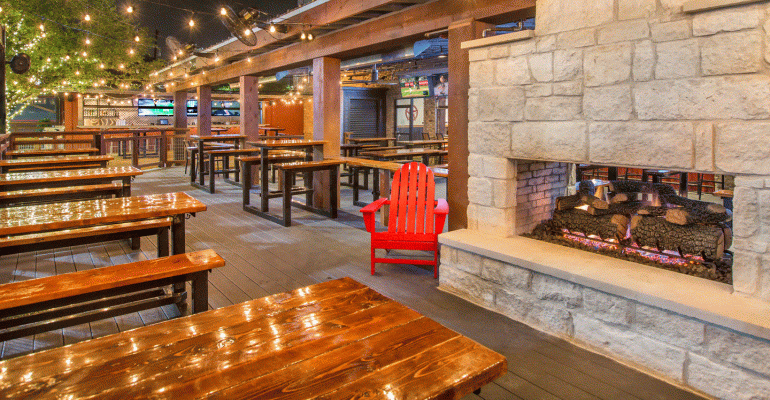As big, legacy casual-dining brands continue to face headwinds, a number of smaller concepts are deploying their deft flexibility as a competitive advantage, growing both unit counts and average restaurant sales.
Examples include BoomerJack’s Grill and Bar’s creative approach to team retention, Firebirds Wood Fired Grill’s twist on restaurant atmosphere and Lazy Dog Restaurant and Bar’s menu aimed at attracting Millennials.
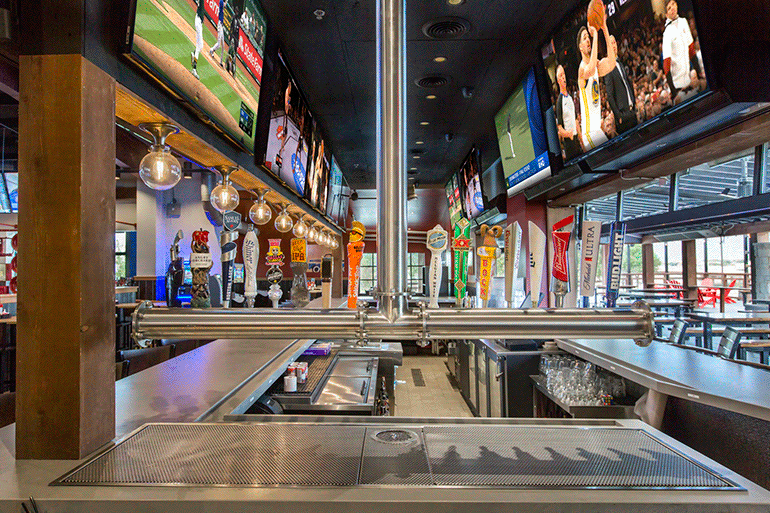
Boomer Jack's
Those smaller brands are bucking an overarching trend that has buffeted casual-dining. For example, of the 62 casual-dining chains in the 2018 Nation’s Restaurant News Top 200, 25 showed sales declines in the latest year. Average sales growth in the segment was an anemic 0.4 percent in the latest year, compared with an average growth of 3.2 percent for Top 200 brands overall.
Take a closer look at how BoomerJack’s, Firebirds and Lazy Dog — which range in size from 13 to 48 locations — have found out-sized success by focusing on their brands’ individual cultural strengths.
Treating employees ‘like family’
Brent Tipps, who founded Fort Worth, Texas-based BoomerJack’s in 2001, credits his 13-unit casual-dining brand’s strength to the concept’s simplicity and its people.
“We’re simple: beer and burgers,” Tipps said in an interview. “We do everything from scratch and treat our people the best way we can possibly treat them.”
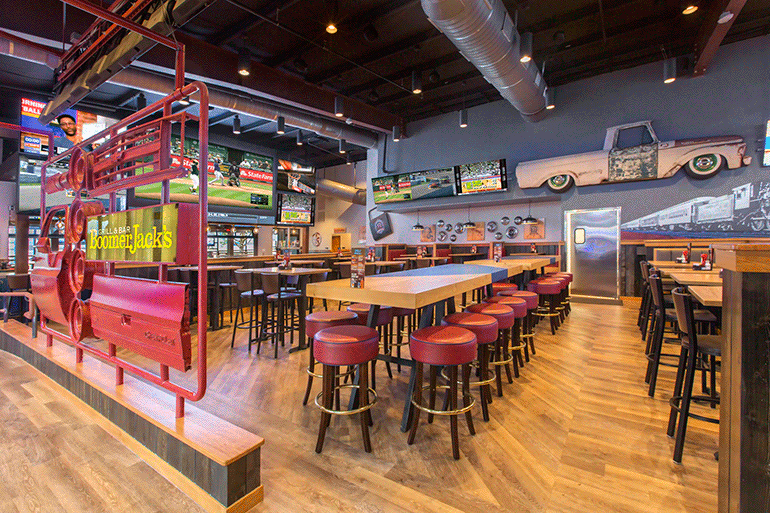
Boomer Jack's
Many of his employees have been with sports-bar-themed company more than 10 years, he said, and Boomer Jack’s retains them by offering schedules that highlight their life outside of work. In the summer months, for example, the company tries to make sure managers take three days off every week.
“That really leads to lower turnover,” Tipps said. “A better-trained staff gives you an advantage. Retaining people by taking care of them is less expensive than not taking care of them.”
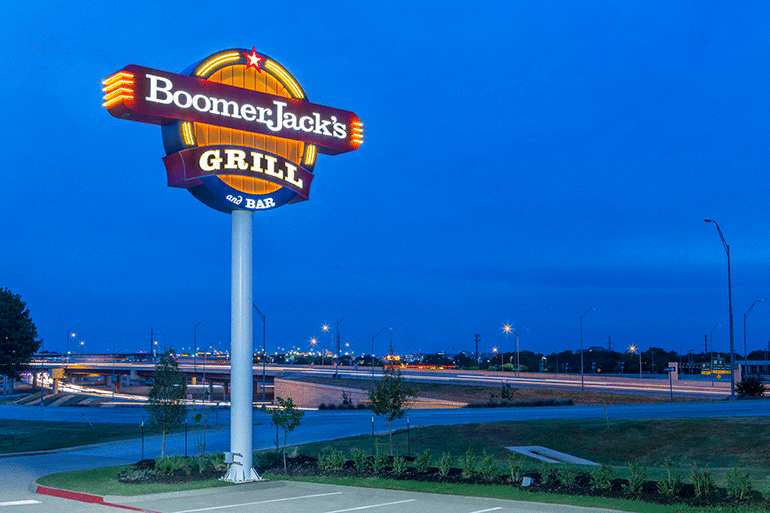
Boomer Jack's
Even the big casual-dining companies are buying into that philosophy. Gene Lee, CEO of casual-dining giant Darden Restaurants Inc., parent to such brands as Olive Garden, LongHorn Steakhouse and Cheddar’s Scratch Kitchen, said in a September earnings call that finding, hiring, training and retaining its workers was paramount.
“The biggest challenge in the industry is going to be the war for talent,” Lee said. “Brands that can hire, train and retain front-line employees to bring their brands to life are going to win, and the dynamics inside the industry are changing dramatically.”
Tipps, a former Cici’s Pizza manager-turned-franchisee, said BoomerJack’s tries to keep managers to a 52-hour workweek.
“You can carry an extra manager at that point,” he said.

Boomer Jack's
Managers also get three weeks of vacation after five years of service.
The newer BoomerJack’s units have large patios. The most recent opening, a 12,200-square-foot restaurant in Grapevine, Texas, also features a 16-foot-video wall. The company plans to open three 10,000-plus-square-foot locations over the next year. Stores range from 50 to 120 employees each.
“We really do it by treating our employees like family,” Tipps said.
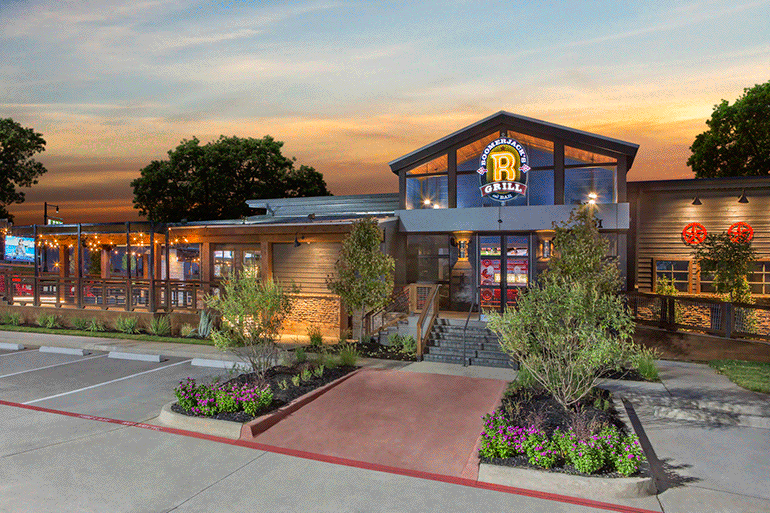
Boomer Jack's
The company, which also owns one Ice House in Bedford, Texas, has been cited twice by the Dallas Morning News as a Top 100 place to work in the region.
Putting a modern twist on decor
With the September opening of its 48th restaurant, its first in Oklahoma, Firebirds Wood Fired Grill continued to make its modern look and its grill menu key points of differentiation.
“The scratch kitchen, ability to butcher in-house and the flavors resonate with guests,” said Stephen Loftis, Firebirds International LLC’s vice president of marketing. “To take it step further, we play in what’s a little bit of the polished-casual segment. People are willing to pay a little bit more for an elevated environment. They can kind of treat themselves.”
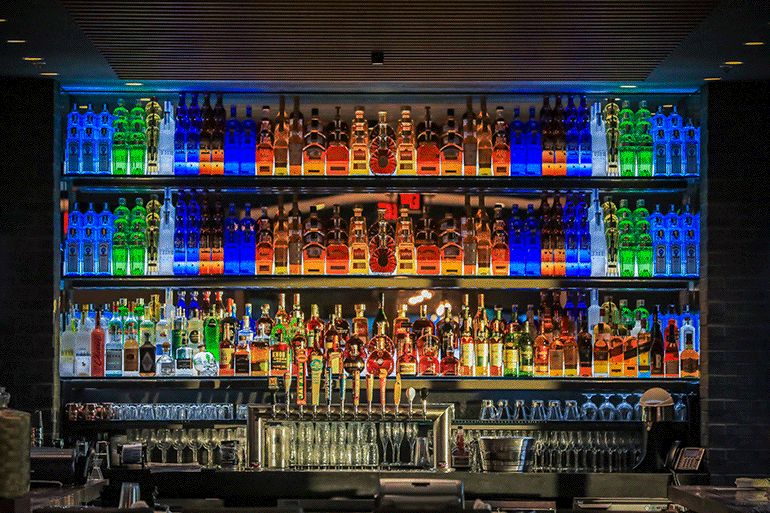
Firebirds
The Oklahoma City Firebirds featured Firebird’s lighter, inviting atmosphere, which breaks from the traditional darker steakhouse look.
The modern design and decor features light-colored woods, charred black brick, floor-to-ceiling windows, exposed wood, contemporary light fixtures, abstract artworks and pops of teal to complement Firebirds’ signature red and orange.
The open-dining-room concept also gives customers a view into the exhibition kitchen and the FireBar lounge, which also provides meal service, Loftis said.
“It’s really a dinner and show,” he said.
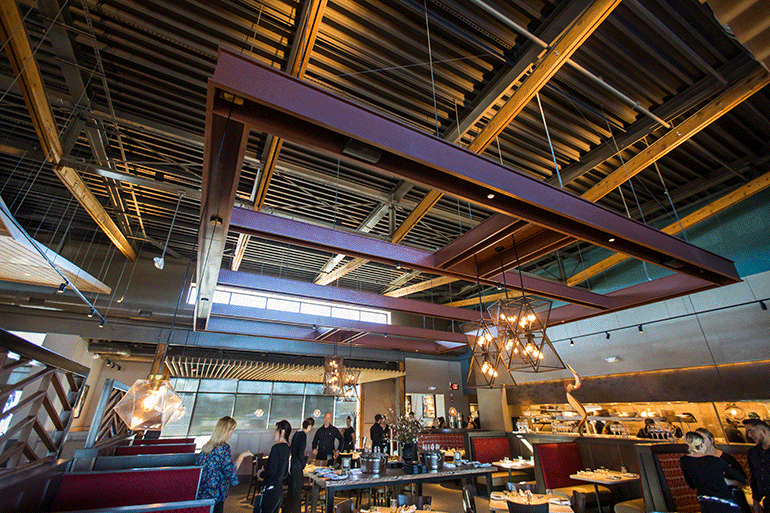
Firebirds
The blended dinner and lunch per-person check average is about $27, with a mix of 70 percent food and 30 percent beverage, Loftis said.
Charlotte, N.C.-based Firebirds now has restaurants in 19 states and plans to open one more before year’s end in Peachtree Corners, Ga., bringing the brand to near the 50-unit mark.
The Oklahoma City restaurant was the fourth unit with the “bit hipper” prototype introduced in Jacksonville, Fla., in late 2017.
“People just love it,” Loftis said. The Oklahoma City location covers about 6,500 square feet with 220 seats, including those on an all-season patio.

Firebirds
“You have to continue to reinvent yourself,” Loftis said, in explaining the brand’s focus. “You have to start at the core: your service model, your touch points. It starts with the food, but you have to make sure you appeal you appeal to a broad demographic.”
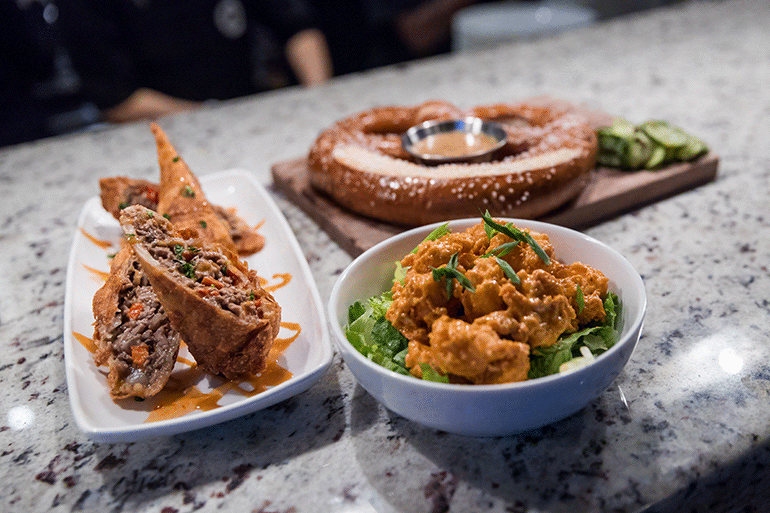
Firebirds
To maintain lunch traffic, Firebirds offers a menu aimed at a slightly lower price point than its dinner offerings and also keeps in mind speed of service.
“That’s a key at lunch,” Loftis said. “We have to make sure we can turn it out. We also ask guests if they are in a hurry and need to get back to the office. We can guide them through the menu.”
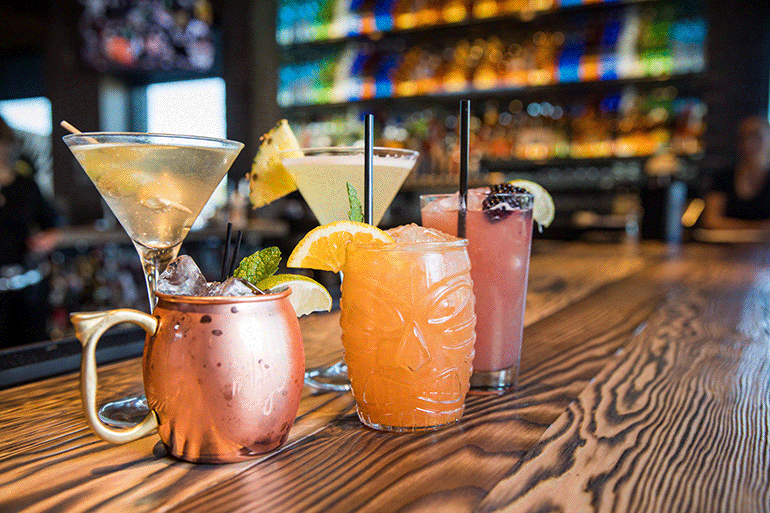
Firebirds
Firebirds has held off on delivery, but it does accommodate online ordering and customer pick up in the restaurant.
Targeting Millennials with ‘continuous innovation’
While Firebirds maintains its wood-fired menu items as point of differentiation, concepts like Lazy Dog Restaurants LLC looks to appeal to the Millennial desire for adventure and creativity.
“The guests today demand continuous innovation,” said Chris Simms, CEO of Lazy Dog, which has about 30 units. “Their awareness of trends happens faster than ever, so we have to do it quickly and nimbly to be first to market.”

Lazy Dog CEO Chris Simms
Huntington Beach, Calif.-based Lazy Dog, which highlights its name with the attached patios that allow customers to bring their dogs, provides a menu — a leather folder with hand-drawn artwork — that features on-trend items like bison meatloaf, blistered green beans with a Vietnamese sauce, and granola croutons and pickled strawberries in a salad.
And the brine used to pickle the strawberries is repurposed as a shrub for cocktails in the bar, Simms said.
“We believe people are looking for something they can trust,” he said. “Authenticity and transparency are important to us.”
The decor, based on Simms’ youth spent on a ranch near Jackson Hole, Wyo., offers an escape to the Rocky Mountains, he said in presentation at the ICR Conference earlier this year. The entryways feature Aspen logs and beams give the bar a lodge-like feel.
“It’s perfect for the Millennial generation that is just entering its child-rearing years, moving into the suburbs but don’t seem to be interested in their parents’ casual-dining options,” Simms said.
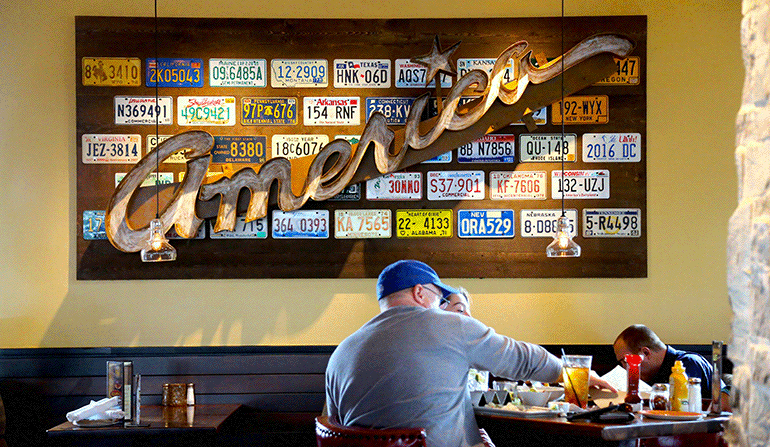
Lazy Dog
And the design is aimed at providing “quality time with friends and family” around fire pits on the patio or coworkers meeting at the bar.
“Everyone can find their happy place at Lazy Dog,” he said.
Lazy Dog has designed its corporate team for growth as well, said Robert Linder, the company’s chief financial officer.
“As we’ve expanded, we’ve worked hard to maintain a good balance between internal promotions and culture-fit new hires,” Linder said.

Lazy Dog
The company has grown from $100 million in revenue in 2015 and to about $170 million in revenue expected this year. Average unit volumes of $6.2 million in 2017 are expected to be about $6.4 million this year, Linder said. Check average is about $19, and the company expects same-store sales to increase about 2.7 percent.
The bar continues to complement the food sales, making up about 24 percent of the mix, Linder said.
Earlier units were about 6,800 square feet, but more recent openings have been about 8,200 square feet with a 1,800-square-foot patio.
“Our patio is extremely important to those guests who want to outdoors with their dogs and for our weekend brunch business,” Linder said.
Contact Ron Ruggless at [email protected]
Follow him on Twitter: @RonRuggless

